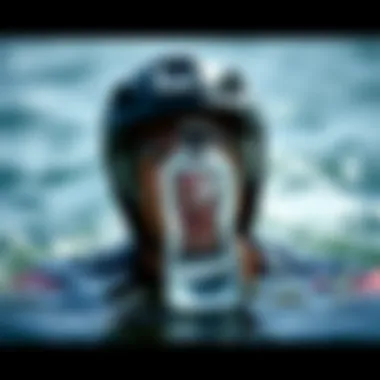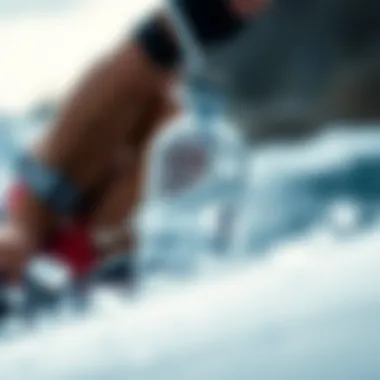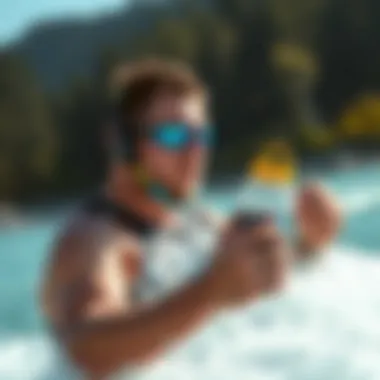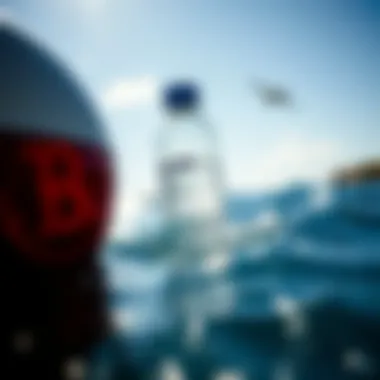Essential Hydration Tips for Watersport Enthusiasts


Intro
Hydration is an often overlooked cornerstone of physical performance, particularly in the vibrant realm of watersports. Many enthusiasts chase the thrill of riding waves, paddling through sea breezes, or navigating lakes, but few give due diligence to how much water they consume. Understanding why hydration matters and how to stay at peak performance can be the difference between enjoying your activity or feeling drained.
As we plunge into this guide, it’s crucial to grasp the physiological implications of water intake. Hydration isn’t just about quenching thirst; it's a fundamental part of how our bodies function. From regulating body temperature to lubricating joints, adequate fluid levels keep the internal engine running smoothly. However, with all the focus on technique and skill, hydration is often pushed to the back burner.
Through this guide, we will uncover methods to monitor hydration levels effectively, ensuring you’re ready to tackle those waters without compromising your health. From beginner tips to advanced techniques, we will navigate the vast ocean of hydration strategies together. By the end, you’ll be equipped to make informed decisions that enhance your performance in your favorite watersports and protect your overall well-being.
The Importance of Hydration in Watersports
When you hit the waves or glide across a clear lake, the excitement of watersports can sometimes mask a vital consideration: hydration. Water plays a crucial role in the performance and well-being of athletes engaged in all forms of physical activity, particularly those submerged in aquatic environments. In watersports, where energy expenditure is often high and environmental conditions can vary,coupled with exposure to sun and wind, maintaining adequate fluid levels is paramount.
Hydration impacts physical performance significantly. Without sufficient water, your body struggles to function optimally. Dehydration can lead to fatigue, reduced stamina, and impaired coordination. You might feel on top of the world before you surf, but once the body starts losing that vital fluid, everything can shift. Muscle cramps and dizziness might become unwanted companions on your adventure. So, it’s crucial to recognize that drinking water isn’t just a side note; it’s a primary player on the stage of athletic success.
Effects on Physical Performance
The link between hydration and physical performance is not just hearsay; it’s grounded in science. Studies have shown that losing even a small percentage of body weight due to fluid loss can lead to a noticeable decline in performance. If you’re engaged in a watersport like kayaking or wakeboarding where reflexes and quick decision-making are paramount, dehydration could be detrimental. The result? A decrease in strength, power output, and overall endurance.
When you’re hydrated, your cardiovascular system operates more efficiently, allowing your heart to pump blood with ease, which means that oxygen gets to your muscles more effectively. This link isn't merely theoretical — it’s practically applicable. Consider the thrills of paddleboarding. Being well-hydrated means you’ll maintain your grip and control, gliding over water instead of battling it.
Maintaining hydration is equally critical during prolonged activities. Whether you are sailing for hours or jet skiing under the blazing sun, fluid replenishment should be a staple of your routine. Ignoring this aspect can turn a great day on the water into an exhausting affair.
Cognitive Function and Decision-Making
Just as dehydration hinders physical performance, it can dampen mental clarity. A watersport enthusiast requires peak cognitive function — whether that’s to navigate tumultuous waters or make quick decisions during intense activities. Studies indicate that even mild dehydration can affect cognition, causing sluggish thinking and delayed reactions.
When your fluid levels dip, you might notice lapses in attention or trouble focusing on the task at hand. Imagine standing on your surfboard, the wave behind you — you need quick judgments and sharp focus. However, if you're not adequately hydrated, your cognitive prowess isn't at its best. You may hesitate, hesitate, hesitate — and that wave might pass you by.
Moreover, effective decision-making involves assessing risks, evaluating your environment, and adjusting to changing conditions swiftly. In watersports where safety can sometimes hang in the balance, being mindful of hydration can make all the difference between a thrilling experience and a potentially hazardous one.
"In the world of watersports, every drop counts. Staying hydrated isn't just a preference; it's a necessity for enhancing performance and ensuring safety."
So, as you prepare for the next adventure on the water, remember: keeping your hydration game strong isn’t just about quenching thirst; it's about ensuring that you’re at the top of your game. Pay attention to your body’s needs, and make hydration a cornerstone of your performance strategy.
Understanding Your Body's Hydration Needs
Hydration is often discussed in a broad sense, but understanding the specific needs of your body is crucial for optimizing performance and well-being in watersports. Everyone's hydration needs differ significantly across various factors; knowing these can be the difference between a stellar day on the water and one filled with fatigue and discomfort. It is essential to pay attention to these unique elements, as they can have a real impact on your sporting experience and overall health.
Factors Influencing Hydration Requirements
Age and Metabolism
Age plays a significant role in how our bodies handle hydration. As we age, our metabolism tends to slow down, which can affect fluid balance and hydration levels. Younger individuals usually have a higher metabolic rate, allowing them to sweat more efficiently and regulate their body temperature better. On the other hand, older adults often experience a decreased thirst sensation, making it easy to overlook hydration needs.
This slower metabolism can make it harder for older athletes to notice the need for replenishment. It's beneficial for this demographic to become more attuned to their watering cues or use reminders to drink throughout the day, especially when engaging in activities like kayaking or paddleboarding. Therefore, staying aware of age-related changes can help inform better hydration strategies.
Environmental Conditions
The environment in which you engage in watersports can dramatically shift hydration necessities. Hot, sunny days expose your body to heat stress, meaning you'll need to drink more to replace lost fluids. In contrast, cooler temperatures might make you feel less thirsty, even as your body still sweats during intense activity.
For instance, when ocean wind combines with high temperatures, you can lose vital moisture through your skin without even realizing it. Hence, whether you're sailing on a calm lake or surfing on a beach with relentless sun, understanding how environmental conditions affect hydration helps you plan accordingly. Dress appropriately, monitor your fluid intake, and more importantly, don’t underestimate hydration needs in less obvious situations.
Intensity and Duration of Activity
The level of exertion during your watersport engagement directly influences how much fluid you require. High-intensity activities, such as windsurfing or racing a jet ski, elevate heart rates significantly, leading to higher sweat production. Conversely, lower-intensity exercises like fishing or leisure kayaking might require less immediate attention to hydration.
It's essential to assess the duration of your activity as well. A quick session might necessitate minimal hydration, while an all-day adventure demands regular intake of fluids, often accompanied by electrolyte replacements. When planning long undertakings on the water, having a hydration strategy—whether through pre-filled hydration packs or scheduled breaks to drink—can keep energy and performance levels up throughout the experience.
Understanding these individual factors empowers each athlete to tailor their hydration practices. Moreover, by being proactive based on age, environmental conditions, and the intensity of activity, watersport enthusiasts can enhance their overall performance and make tbe most out of their time spent on the water.
Daily Hydration Recommendations
Hydration is not a one-size-fits-all solution but rather a spectrum influenced by individual variables. While general guidelines suggest drinking about 2 to 3 liters daily for average adults, watersport athletes need to adjust their intake based on personal needs.


- Men should aim for approximately 3.7 liters per day.
- Women require around 2.7 liters.
Event-based adjustments are also crucial. Before starting your adventures, make sure to hydrate adequately, consider replenishing fluids during activities, and critically ensure proper recovery hydration afterward. Developing a personalized plan, combined with the previous sections' insights, amplifies your performance and can lead to remarkable experiences on the water.
Hydration is the cornerstone of sports performance—neglect it, and you might pay the price in fatigue or worse.
By keeping these hydration needs in mind, you can set yourself up for success, ensuring enduring energy and enjoyment while navigating watersports.
Methods to Check Hydration Levels
Understanding your hydration levels is essential for anyone participating in watersports, as even slight dehydration can have serious effects. Knowing how to assess if you are drinking enough fluids can keep you performing at your best while enjoying your time on the water. This section dives into practical methods to check hydration levels that are simple and effective, helping enthusiasts stay on top of their water intake.
Visual Inspection: Urine Color Assessment
One of the easiest methods for checking hydration is through urine color assessment. The color of your urine speaks volumes about your hydration status. When well-hydrated, urine should appear light yellow to clear. On the other hand, darker shades indicate that you may need to reach for a drink.
A simple guideline is the "lemonade" scale: If it’s as clear as water, keep sipping; if it resembles apple juice or darker, it’s time to hydrate.
However, there are some variables at play. Certain dietary choices and supplements can alter urine color. For instance, beets can give a reddish tint while B vitamins may cause a neon yellow hue. Therefore, being aware of your recent food intake helps in making accurate assessments.
Monitoring Thirst Signals
Another method that often goes overlooked is paying attention to your body's thirst signals. Thirst is your body’s natural way of saying it needs more fluids, but it shouldn’t be the primary indicator alone. Sometimes, people become dehydrated before they feel thirsty, especially during intense watersport activities.
To mitigate this gap, it's wise to drink regular amounts throughout your activity, rather than relying solely on thirst. Keep a water bottle handy and take sips frequently, particularly during breaks or transitions between activities.
Body Weight Fluctuations
Evaluating body weight fluctuations can provide insights into your hydration needs. Weighing yourself before and after a long watersport session can reveal how much fluid you’ve lost during that time.
For example, if you weigh 70 kg before heading out and 68 kg afterward, that’s a loss of 2 kg, which translates roughly into 2 liters of fluid loss. A good practice is to replace every kilogram lost with approximately 1-1.5 liters of water or an electrolyte solution for optimal recovery.
Sweat Test and Fluid Loss Measurement
The sweat test is another intricate method to check hydration levels. Understanding how much you sweat can inform about your hydration status. To conduct a basic test, you can weigh yourself before and after a set time of exercise, ideally performing a controlled activity in similar conditions.
- Weigh yourself naked before the activity.
- Perform your watersport for a set time, ideally an hour.
- Dry off any sweat after the activity and weigh yourself again.
- Note the difference in weight.
From this, you can assess how much fluid loss has occurred simply through sweat. This number can help determine personal hydration strategies based on individual sweat rates.
Hydration Strategies for Watersport Activities
Hydration plays a crucial role for anyone involved in watersports. Whether you’re a seasoned pro or an enthusiastic beginner, knowing how to navigate your hydration can keep you sharp, energized, and performing at your peak. In high-energy sports like surfing, sailing, or jet skiing, the visibility of hydration strategies can mean the difference between a lackluster day on the water and a truly exhilarating experience. Here, we’ll dissect some practical and effective hydration strategies for various watersport activities, looking closely at different phases surrounding your time on the water.
Pre-Activity Hydration Practices
Before diving into your chosen watersport, pre-activity hydration is essential. Preparing your body for exertion can help prevent dehydration and enhance overall performance. It’s widely recognized that drinking adequate fluids in the hours leading up to activity can boost your stamina and mental acuity when you hit the waves.
One effective practice is to drink about 500 mL of water or a hydrating beverage approximately two hours before your activity begins. This timing allows your body to absorb fluids better and helps you avoid a visit to the restroom every five minutes once you’re on the water. Additionally, consider incorporating electrolyte-rich beverages to increase your body’s readiness.
"Hydration before activity is like fueling a car; no fuel, no go!"
This simply means that maintenance of fluid intake sets the stage for your performance.
Hydration During Watersport Engagement
Fluid Replacement during Activity
When it comes to maintaining hydration while in the midst of an activity, fluid replacement is crucial. Engaging in strenuous physical activity leads to sweating, which can significantly lead to fluid loss. The goal should be replenishing that lost fluid to ensure peak performance. The general rule of thumb is to drink about 200-300 mL of fluid every 20 minutes during prolonged activities. A good characteristic of fluid replacement strategies is their adaptability to personal preferences and conditions.
Popular options include water, sports drinks, or coconut water--all of which can help restore lost fluids. However, there’s a nuance to consider:
- Sports Drinks: Often contain simple carbohydrates which can provide an energy boost.
- Water: Best for shorter durations where a quick replenishment is sufficient.
Each option has its necessary pros and cons, depending on the duration and intensity of the activity. If you’re spearheading into a 4-hour surf session, opting for a sports beverage might provide that extra edge you need.


Electrolyte Balance Considerations
Equally important to the fluid itself is maintaining electrolyte balance. When you sweat, you’re not just losing water; you’re losing essential salts like sodium, potassium, and magnesium. These electrolytes help regulate muscle function and nerve conduction. This makes electrolyte balance vital to ensure your muscles aren’t cramping after a long day on the surfboard.
The best approach during engaging activities is to select beverages that provide both hydration and electrolytes. Specialty electrolyte tablets dissolved in water can also be a popular choice, especially for those who find sweet drinks overly sugary after long periods. It’s wise to test different options during practice, as each individual reacts differently to variations in electrolyte intake.
Post-Activity Recovery Hydration
Finally, post-activity recovery hydration is just as vital as pre-activity measures. Replenishing fluids lost during your fun in the sun should be done promptly, ideally within 30 minutes of completing your activity. This is because your body is like a sponge at that moment and eager to absorb more moisture.
Ideally, you should aim for a blend of water and a recovery beverage specially designed to restore lost electrolytes. This practice not only helps reduce drying out from activity but also promotes quicker recovery, allowing you to be ready for your next challenge on the water in no time.
Each phase of hydration—before, during, and after—plays a critical role in ensuring you remain at the top of your game, making the love for water-based activities an enduring affair.
Common Myths About Hydration
In the world of watersports, staying adequately hydrated is not just a tip—it's a necessity. However, there's a lot of misinformation floating around about what proper hydration really entails. Understanding these common myths can shed light on best practices for fluid intake, ensuring athletes, coaches, and enthusiasts are better equipped for their activities. Let's dive into some of the most prevalent misconceptions.
The Notion of Thirst as a Reliable Indicator
One prevalent myth is that the sensation of thirst is a reliable indicator of hydration status. In reality, this notion falls short. By the time you feel thirsty, your body may be signaling already that it needs fluid. Thirst is a lagging indicator; it often means that dehydration has already begun to take hold. This is particularly crucial during intense activities in warm climates, where you may sweat more than you realize.
Many athletes might wait until they feel parched before reaching for their water bottle, but this practice can lead to delays in replenishing lost fluids. Especially during long surfing sessions or while sailing, where cognitive function and motor skills are key, waiting to hydrate until you feel thirsty can impact performance. For best results, proactive hydration strategies should be implemented.
"Don't wait until you're thirsty; hydrate with purpose upfront to maintain performance and focus."
A smart approach is to drink small amounts regularly throughout the activity rather than gulping down large quantities sporadically. This way, your body can better maintain optimal hydration levels.
Water versus Sports Drinks
When it comes to hydration options, the debate between water and sports drinks is rife with opinions. Many athletes may think that water is all they need. While it's true for shorter or less intense sessions, the narrative changes with prolonged exertion.
Sports drinks contain electrolytes—minerals like sodium, potassium, and magnesium that are essential for rehydration and overall bodily function. When you're sweating heavily, especially in water activities, you not only lose water but also these crucial salts. Thus, consuming a sports drink can help restore balance, particularly during high-intensity or extended activities.
On the flip side, overconsumption of sports drinks when they're not truly warranted can lead to unnecessary sugar intake. It's vital for athletes to assess their needs, considering factors such as activity duration, intensity, and environmental conditions, before deciding on their hydration strategy.
In summary, both water and sports drinks have their place in an athlete's hydration regimen. Here's a quick breakdown:
- Water: Best for general hydration during low-intensity activities or short workouts.
- Sports Drinks: Beneficial for longer sessions where electrolytes need replenishment, particularly in hot conditions.
Choosing wisely between these options can significantly impact performance, making it worthwhile to understand when to opt for one over the other.
Choosing the Right Hydration Products
When it comes to hitting the waves, staying hydrated isn't just a suggestion—it's a necessity. This section focuses on selecting the appropriate hydration products to enhance your experience in watersports. Having the right tools not only aids in meeting hydration needs but also affects performance and recovery in significant ways.
Overview of Sports Drinks and Their Benefits
Sports drinks, often buzzing in conversation among athletes, serve a purpose far beyond merely quenching thirst. These beverages are formulated to restore fluids and electrolytes lost during rigorous activity. As the temperatures rise and the water splashes, understanding the balance of ingredients in sports drinks becomes crucial.
The main components of sports drinks typically include:
- Electrolytes such as sodium and potassium, crucial for nerve function and muscle contractions.
- Carbohydrates that provide energy for extended activities.
- Flavors and colors that make the drink appealing but should be scrutinized for artificial additives.
One noteworthy point is that not all sports drinks are created equal. Some are overly sugary and can lead to dehydration rather than helping it. This means it might be wise to scrutinize labels before popping the top on a can or bottle. Caution is also the name of the game when mixing sports drinks, as diluting them could enhance absorption, depending on your intensity.
Hydration Packs and Bottles: What to Consider
The choice of hydration packs and bottles goes hand in hand with the type of watersport. With aqua adventures often demanding a level of mobility, having the right gear can make or break your day on the water. Here are some key considerations on hydration receptacles:
- Material and Durability:
- Capacity:
- Ease of Use:
- Tube Systems:
- Weight:
- Plastic: Lightweight and affordable but may retain odors.
- Stainless steel: More durable and offers insulation capabilities but can be heavier.


- Depending on activity duration, a larger capacity might be more beneficial. Many hydration packs provide between 1.5 to 3 gallons of water.
- Look for bottles with wide openings for easy filling and cleaning.
- On the go? Opt for nozzle designs that allow quick sips without breaking stride.
- For packs, ensure the tube is long enough to reach comfortably while engaged in your sport.
- Any additional gear can become cumbersome. Thus, prioritize lighter options especially for more physically intense excursions.
The choice of products must align with your specific watersport and activity level. Whether paddling in a kayak or shredding waters on a jet ski, the right hydration tools will help in maintaining performance while avoiding the dreaded spectacle of dehydration.
Choosing the wrong hydration product is like sailing a boat with holes—it won’t take long before you’re in trouble.
Familiarity with various hydration products will arm you with the insights needed to make informed decisions, thereby enhancing your time on the water.
Adapting Hydration Techniques for Different Watersports
Hydration strategies aren't a one-size-fits-all deal, especially in the diverse realm of watersports. Each activity demands a tailored approach, taking into account the specific physical demands, environmental conditions, and the duration of engagement. The right hydration techniques can significantly enhance performance, stave off fatigue, and reduce the risk of heat-related illnesses. Recognizing how different watersports impact hydration needs allows enthusiasts to make more informed choices, ensuring they remain at peak performance on the water.
Surfing Considerations: Timing and Technique
When surfing, the timing of hydration is crucial. Surfers often face extended periods of physical exertion coupled with sun exposure, which can lead to rapid fluid loss.
- Pre-Surf Hydration: It's essential to hydrate well before hitting the waves. Ideally, surfers should consume fluids about 1-2 hours before their session. This gives the body time to absorb the water, minimizing any likelihood of cramps.
- Hydration During Sessions: The challenge here is finding the right time. Surfers may not have a chance to drink water after paddling out, and the adrenaline can mask thirst. Techniques like using a hydration pack or a water bottle attached to your board can help ensure that you’re drinking while taking breaks between waves.
- Post-Surf Recovery: After a taxing session, replenish fluids that were lost. Recovery drinks containing electrolytes can be particularly helpful, especially after a long day on the water.
"Staying hydrated isn’t just about drinking water; it’s about doing it at the right moments for optimal performance."
Sailing and Hydration: Managing Exposure
Sailing presents unique challenges tied to hydration management. Whether you're racing or leisurely cruising, the exposure to sun, wind, and sometimes salty air necessitates a well-thought-out hydration plan.
- Humidity and Temperature Effects: Sailing often involves long hours in a hot sun, which can lead to increased perspiration and dehydration. Even if it doesn’t seem hot, wind can be misleading. Many sailors underestimate their need for fluids. Keep this in mind: it’s not always the heat that’s a problem, more the cumulative effects of exposure.
- Hydration Techniques: Sailors should aim to drink small amounts of fluids consistently throughout the day instead of waiting until they feel thirsty. Having a dedicated water station on board, equipped with a refillable water jug and cups, encourages frequent sipping among crew members.
- Electrolyte Balance: Given the salty environment, maintaining electrolyte levels should not be overlooked. Choose drinks that replenish sodium, potassium, and magnesium. Products like coconut water or sports drinks can help mitigate losses from perspiration.
Ultimately, being proactive about hydration in sailing can prevent fatigue and enhance overall crew performance.
Tailoring hydration techniques to specific watersports ensures enthusiasts stay at their best, maximizing enjoyment and performance. Always remember, keeping fluid levels up isn’t just smart — it’s essential.
The Role of Technology in Hydration Monitoring
In the age of innovation, keeping track of your hydration needs has never been easier. Modern technology has significantly changed how athletes, particularly those involved in watersports, monitor their hydration levels. With reliable data at their fingertips, enthusiasts can make informed decisions that ensure their wellness and performance remain on point. As we delve into this subject, we will explore the various tools and methods available today, along with their unique benefits and considerations.
Wearable Devices and Hydration Tracking Apps
Wearable technology has truly revolutionized daily routines and athletic training alike. When it comes to hydration, devices like smartwatches or fitness bands offer features that directly address fluid intake. These tools provide real-time data, assisting users in understanding their specific hydration levels based on activity, environment, and physiology. Here are some aspects worth considering:
- Convenience and Accessibility: A large number of fitness enthusiasts are turning to devices that can easily track hydration without the need for manual input. With a simple glance at the wrist, individuals can see their hydration status.
- Integration with Fitness Goals: Many of these devices sync with various apps, allowing athletes to better align their hydration with broader performance aspirations. This integration enables users to plan their hydration around intense training sessions or competitive events.
- Custom Alerts and Reminders: Many tracking apps offer customizable alerts to remind users when it’s time to hydrate. This feature can be indispensable, especially during long sessions of watersport activities, where losing track of time is commonplace.
- Data Analysis and Trends: Over time, the accumulation of hydration data can reveal trends in one's performance relative to fluid intake. This insight can be critical for strategizing future training or competition hydration plans.
Using these technologies effectively requires some thought. Not all devices measure hydration accurately; some rely on general algorithms that could miss the mark. Being discerning about which product you choose is crucial. It’s also essential to complement device data with traditional methods of hydration assessment, such as urine color monitoring or assessing thirst signals, to create a comprehensive view of your hydration status.
Incorporating technology doesn’t eliminate the need for a fundamental understanding of hydration—rather, it enhances it.
Ultimately, while wearable devices and apps have made hydration monitoring more intuitive, individuals must remain proactive and educated about their unique hydration requirements. Knowing whether a device meets your needs can mean the difference between optimal performance and a disappointing experience on the water. For those willing to invest the time and effort, technology can provide invaluable support along their journey in watersports, smoothing the slippery path toward peak performance.
For more insights, consider checking resources like Wikipedia or fitness forums on Reddit for discussions on hydration technology trends.
End: The Critical Role of Hydration
Hydration is more than just a buzzword tossed around in fitness circles; it is the linchpin of performance, especially for those who engage in watersports. Whether you're gliding across the water in a kayak or catching waves while surfing, ensuring you are properly hydrated can dramatically impact how well you perform. It’s common knowledge that the human body is largely composed of water, but understanding the depths of this connection between hydration and performance is essential.
First and foremost, let’s consider the physiological benefits. When you are adequately hydrated, your muscles function more efficiently, your endurance increases, and fatigue sets in at a slower pace. Poor hydration can not only lead to decreased performance but can also result in serious health risks like heat stroke, muscle cramps, and even cognitive dysfunction. In other words, being mindful of your fluid intake is not just about physical stamina; it’s about keeping your head in the game as well.
"Proper hydration not only supports peak physical performance but also sharpens cognitive functions, crucial for making quick decisions on the water."
Moreover, the various factors influencing hydration can’t be dismissed. Age, metabolic rate, and even the environment all play a role in how much water one needs. Therefore, a universal approach or one-size-fits-all guideline concerning fluid intake falls short. For instance, a younger athlete paddling in warm weather will require different hydration strategies than an older sailor navigating cooler climates. Tailoring hydration practices to individual needs is essential for optimizing results.
In light of these factors, implementing effective hydration strategies is necessary. As touched upon earlier in this article, hydration can be managed pre-activity, during, and post-activity. Each phase has specific needs and considerations. Pre-hydration ensures you start strong, while maintaining fluid levels during activities keeps you from hitting a wall. Finally, post-activity hydration is crucial for recovery, flushing out toxins and repairing muscles. If you’re looking to maximize your time on the water, understanding how to properly handle your hydration should be non-negotiable.
It’s essential to bust some myths surrounding hydration, too. The idea that thirst is a reliable indicator of your hydration status can lead to trouble, especially during intense activities. By the time you’re thirsty, your body signaling you to drink might mean you're already in a deficit. Thus, proactive hydration measures should be taken rather than waiting for thirst to kick in.
Lastly, we cannot overlook the influence of technology in assisting hydration monitoring. With the introduction of wearable devices and applications designed to track fluid intake and remind users to drink water, staying hydrated has become more streamlined. These tools provide a level of accountability that can help you stay aligned with your hydration goals while engaging in your favorite watersports.
In summary, hydration is a critical pillar of performance for watersport enthusiasts. The benefits are manifold, from enhancing physical abilities to maintaining cognitive sharpness. By understanding the factors influencing hydration, employing effective strategies tailored to your specific needs, and utilizing technology, you can navigate the waters with confidence and vitality. Remember, watersports should invigorate you, not drain you; and hydration is the key to steering clear of any pitfalls in your aquatic pursuits.















